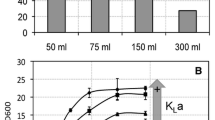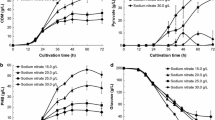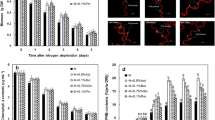Abstract.
Azotobacter chroococcum MAL-201, when grown under nitrogen-free conditions with excess glucose, accumulated poly-β-hydroxybutyric acid amounting to 75% of cell dry weight at the late exponential phase. This led to induction of encystment, which increased steadily with concomitant intracellular degradation of the polymer. Increase in encystment and PHB production were parallel up to 0.5% (wt/vol) glucose. Further increase in glucose reduced cyst formation but enhanced PHB accumulation. Replacement of glucose by n-butyl alcohol and metabolically related compounds identified crotonate as the best encystment inducer followed by β-hydroxybutyrate and butyrate, but PHB production was inhibited in general. Supplementation of medium with these compounds enhanced the onset of encystment, and only β-hydroxybutyrate increased PHB accumulation significantly.
Similar content being viewed by others
Author information
Authors and Affiliations
Additional information
Received: 23 April 1997 / Accepted: 31 May 1997
Rights and permissions
About this article
Cite this article
Pal, S., Manna, A. & Paul, A. Induction of Encystment and Poly-β-Hydroxybutyric Acid Production by Azotobacter chroococcum MAL-201. Curr Microbiol 35, 327–330 (1997). https://doi.org/10.1007/s002849900263
Issue Date:
DOI: https://doi.org/10.1007/s002849900263




